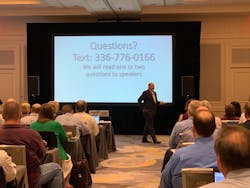Leveraging the Grid’s Human Vulnerabilities to Improve Reliability
On September 11, 2001, FDNY Chief Joseph W. Pfeifer noticed the out-of-place roar of an airplane in lower Manhattan. He looked up to see the first plane crash into the North Tower of the World Trade Center. Pfeifer immediately sprang into action, becoming the first chief to arrive at the twin towers. What followed was a series of moments, intuitive and analytical decisions, and sacrifices—by him and thousands of others.
More than 400 linemen, technicians, firefighters, psychologists and aviation engineers from more than 180 different organizations gathered in Atlanta for the eighth annual Human Performance Conference: Improving Human Performance on the Grid, which focused on improving performance at the organizational, process and individual levels.
Pfeifer’s message and the message of the Human Performance Conference was clear: despite their different backgrounds, their individual histories and life experiences, there are real men and women who have their hands on the controls of their industries—humans who will bear the weight, the responsibility and the real-world consequences that are at stake. There are days when those consequences may be life or death.
This annual conference—a collaboration between NERC, the North American Transmission Forum (NATF) and the Department of Energy (DOE)—provided the space for industry to come together, leverage their commonality and vulnerability, and learn how to achieve a culture of high reliability on the bulk power system.
Presenter after presenter stressed the importance of a good corporate culture, “the tone at the top,” as well as how high-reliability organizations get the results that they desire. In order to achieve that culture of high reliability, a “just culture,” which focuses on the real-time evaluation of behavioral choices in a rational and organized manner within a company, must be implemented. Under the just culture model, creating an open, fair, and just culture relies on developing managerial competencies that appropriately hold individuals accountable for their behaviors and openly investigate the behavior that led to the error, with a purpose of fixing the system, not necessarily the individual.
Just culture breaks human behavior into three categories and treats them accordingly: human error, at-risk behavior, and reckless behavior. Human error is an inadvertent action—a slip, lapse, or mistake. At-risk behavior is a behavior choice that increases risk where risk is not recognized or is mistakenly believed to be justified. Reckless behavior is a behavioral choice to consciously disregard a substantial and unjustifiable risk.
The just-culture model also provides a scaled response, independent of the outcome:
- Console the human error. Manage the human error through changes in choices, processes, procedures, training, design and environment.
- Coach the at-risk behavior. Manage the at-risk behavior through removing incentives for at-risk behaviors, creating incentives for healthy behaviors and increasing situational awareness.
- Sanction the reckless behavior. Manage the reckless behavior through remedial and punitive action. Just culture addresses the error then moves on to the task of building a better system that will produce a better outcome with a goal of operational excellence.
We know that perfection isn’t possible or achievable, and we know that all industries face human factor issues when people interface with complex equipment. So, we must simply do our best to design to tolerate human error and mitigate harm, avoid self-interested human behavior, and create a culture that both supports open and honest reporting and provides the tools for fair and consistent outcomes.
The study of Human Performance enables entities to better understand the reasons mistakes occur and apply lessons learned from past events and near misses so that events can be avoided. Collaborative events, like this conference, take advantage of the expertise in the room, allowing attendees to begin to see things at the strategic, tactical and operational level, which moves performance to the next level. Human Performance analyses and applications, lessons learned, and good industry practices are being applied daily to further improve the reliability of the bulk power system.
This annual conference is an opportunity for industry members to come together, interact and improve their individual and organizational abilities as well as honor the role that people play daily in the operation of the transforming electric grid. Presentations from the conference will be posted on the NERC website in April. Previous conference presentations can be found here.
